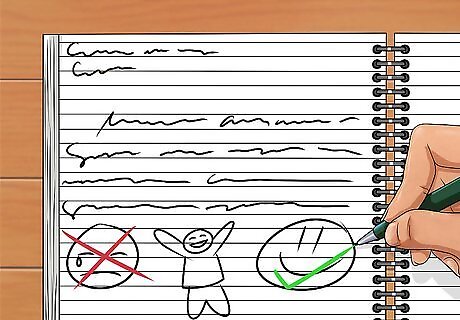
views
Organizing a Journal

Choose a journal medium. You can keep a journal in many forms, from digital to analog and aural to visual. The important thing is that you choose a journal medium which inspires you to write. If no medium leaps out at you as the right choice, try journaling in various ways until something sticks. Use an analog notebook if you prefer to set your thoughts down with a pen or pencil. Jot down your thoughts in an old spiral notebook, if that captures your fancy, or buy a leather-bound journal so that you can start fresh. Use a small notebook for portability, or a large notebook to conceptualize big ideas. Make sure to choose a pen that feels good in your hand. Keep a journal on your computer or your phone, if you prefer to type. Use a standard word processor (like Word or Notepad) or anything other program that feels right. Save all of your journal entries into one document, or save each entry into a new document within a "Journal" folder. It may be most convenient for you to journal on your computer if you also work from your computer. If you like the idea of making your thoughts more public, consider keeping an online journal. Build a simple page on a free blog site like WordPress or LiveJournal. Post regular journal entries. You don't need to share the link with anyone, or try to amass a following – the very act of posting online may help you keep yourself accountable. Consider keeping an audio journal. If you are more comfortable speaking than writing, consider recording your thoughts to the voice recorder app on your smartphone or computer. Sit down with the recorder and talk through your thoughts for a few minutes – you may find that you process emotions better through talking.

Find a calm, quiet space to get in touch with your emotions. Consider writing at home, at a cafe, at the library, or out in the woods. Clear your mind of distractions. Try to remove your head from everyday life, however temporarily, and slip into a state of deep introspection. If you can't find physical space, try to create a mental bubble: listen to ambient music or white noise on headphones; shut yourself into a quiet, enclosed space; climb a tree, or find your way up to a roof. Consider meditating or sitting quietly before you begin to write. This can help silence distractions and focus your thoughts. Stretch, breathe deeply, light candles, or play gentle music – anything that puts you into a calm, reflective state.

Make a habit of journaling. Introspection takes regular practice. Make a goal to write each day, whether you set down a few sentences or a few pages. Set aside 10-30 minutes to journal with no procrastination or delays. Be disciplined. If you have an especially busy schedule, consider setting one specific time to journal each day. Journal just before breakfast, on the train to work, or at night before you drift off to sleep. Find a time at which your thoughts are clear. Try leaving your journal somewhere convenient so that it isn't a hassle to start writing. Take it with you when you leave the house, and always keep a pen handy!

Consider logging the date and time of every entry. This way, it's easy to refer back to specific events and look for patterns in the things you've written. If you are writing a sequential journal, the entries will fall into a sort of loose chronology of their own accord – but a more precise log may help you reference concrete events. Try logging any information that you feel is relevant to what you write. This may include the weather, the season, the significance of a given day (birthday, holiday, etc.), or the reason that you're writing this particular entry.
Beginning to Write

Decide what you want to write about. Ask yourself what's going on in your life; how you feel; what you're thinking about; and what you want. Identify the issues and emotions that you need to explore. If you've been dwelling on something lately, there's a good chance that it will rise to the surface as the focus of your examination. Close your eyes and take a deep breath – inhale, then exhale. Review the ideas, events, or emotions that are most pressing.

Time yourself. Write for 5-20 minutes, or as long as you feel inspired. Write the start time and the end time at the top of the journal page. Set an alarm on your phone, clock, or computer so that you don't need to keep checking the time. This way, you'll be able to fully immerse yourself in the writing process. If set writing times aren't your style, feel free to write for as long as you like. The aim of a timed writing session is to practice the process of sustained writing. If you want to write something cumulative, there's nothing wrong with taking extra time to flesh out a thought – or with refraining from times at all.

Start writing. Set your pen to the page and don't take it away until the time is up. Try to channel the thoughts directly from the top of your brain. Try not to be critical of yourself while you are writing – this might take you out of the moment and impede your flow. Start with a simple topic sentence—something that sets the tone for everything else you'll write—as though you were starting a conversation with a friend. Review these example sentences: Today was the greatest day that I've had in months. Where do I start? I don't know what to do. I can't do this anymore. I'm beginning to suspect that Dan is cheating on me.

Re-read what you've written. When you finish writing, read over your new journal entry. Write a sentence or two of reflection: “As I read this, I notice—” or “I’m aware of—” or “I feel—”. Consider whether there are any actions that you can take based on what you wrote. If so, figure out what you need to do to make them happen.
Getting Introspective

Journal what you feel. Whenever you have a strong emotion, record it in your journal. Write what you are feeling, what triggered that feeling, and what you're going to do about that feeling. Use your journal as a way to process feelings in the moment. If you feel overwhelmed, you might be able to release some of the tension by simply setting your thoughts down on paper.

Evaluate your actions, your thoughts, and your emotions. Write about what you did and how you did it. Write about what you thought and what you felt. Question what you did, and answer your own questions. Focus on the logical progression of your thought processes, and try to better understand yourself. Journaling can help you understand your behavior and your emotional responses, as well as where they are coming from. Once you understand that, you can really start to improve your quality of life. Write about what you feel that you could or should have done; write about what you feel about what you chose to do; write about who you are; and write about what you want. Try to define your goals for the future, whether they are personal, professional, or otherwise.

Journal in conjunction with your therapy sessions. Record your thoughts about your most recent session, and take note of anything interesting that you learned. Experiment with journaling during your sessions, directly after your sessions, and later on when you reflect upon your experience. Set personal goals with your therapist, and use your journal to track them. Some therapists are actually trained in journal therapy. If you'd like to explore journal therapy with an intentional and professional guiding hand, consider finding a licensed journal therapist in your area.

Don't be afraid to get creative. If you feel that you can best express a thought by drawing it out, do not hesitate to do so. Use color! Paint, marker, crayon. Consider pasting photos, clippings, flowers, and other ephemera into your journal – anything that feels meaningful. Try to incorporate scrapbooking. If your therapist gives you any worksheets or print outs of useful info, stick them in your journal! Use your journal as a scrapbook of self help techniques. Create lists of things that make you happy and triggers you should avoid. Consider drawing "mind maps" to connect your ideas. Draw lines, arrows, or webs between related ideas. Find the themes that arc across your troubles, and try to identify the various ways in which they manifest.

Go into detail. Later on, it can be easy to forget why you wrote or drew something. Push deeper, and try to flesh out your thoughts as thoroughly as possible. The more fully you examine your worries, the better you'll be able to understand them. The better you understand your worries, the more easily you'll be able to overcome them.

Give yourself writing prompts to stimulate your self-inspection. Look for journal prompts on the Internet, ask a friend or a therapist for ideas, or try to come up with a few solid themes that you want to explore. Having a different question or journal prompt to answer each day can be a great way to keep up with writing. When you write to a prompt, you may feel more like you're writing to someone instead of just writing for yourself, and you may feel accountable to the journal structure. Consider these questions and more: Are you proud of who you are? How would you like to be remembered? What is a personality trait that you admire or seek in others – and why? Think about something you feel obligated to do, daily or regularly. Why do you feel obligated? What is the best advice that anyone's ever given you?

Think of your journal like a friend. Journaling can simulate the feeling of pouring out your feelings to a close, trustworthy friend. Try to address your journal as though it's a close friend who anticipates each new entry; imagine that it is eager to learn of your progress through life, and that it cares about your emotional well being. The feeling of a one-on-one "relationship" can tap into the therapeutic effect of sharing experiences.

Read through your journal regularly. Compare the things you have written recently with the things you wrote six months ago. Look for patterns, and try to chart your personal development. It may be difficult to go through the negative emotions again, but you will know you are progressing when you can remember these feelings without feeling swept away by them.




















Comments
0 comment